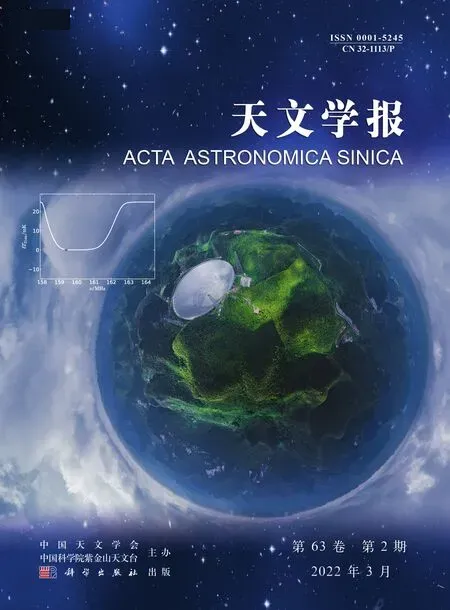日冕物质抛射及其驱动激波的多波段和多视角研究
应蓓丽
(1 中国科学院紫金山天文台 南京 210023)
(2 中国科学技术大学 合肥 230026)
日冕物质抛射(Coronal Mass Ejection, CME)是太阳大气中剧烈的爆发现象之一. 其爆发通常能释放大量的能量并抛射大量磁化等离子体. CME所驱动的激波能进一步导致太阳高能粒子事件(Solar Energetic Particle,SEP)的发生, 并可能影响航天器和宇航员的安全. 因此,研究CME及其驱动激波的形成机制和性质有利于我们更加清晰地了解及监测它们的运动过程, 降低它们带来的灾害性空间天气的影响. 本文主要以分析观测数据为主对不同CME事件及其驱动激波进行了多方面研究. 我们利用多个仪器的观测分析了4个不同尺度的CME事件.观测数据主要来自SOHO (Solar and Heliospheric Observatory)、SDO(Solar Dynamics Observatory)和STEREO(Solar Terrestrial Relations Observatory) 3个卫星.
首先, 我们分析了一个发生于2015年11月4日的小尺度短时标的太阳爆发事件, 与其相关的M1.9级耀斑脉冲相持续时间很短(<4 min). 与大尺度的CME爆发事件相比, 这个CME热通道主加速相持续时间短(<2 min)、最大加速度大(~50 km·s-2)以及峰值速度高(~1800 km·s-1)的特性十分突出. CME的快速脉冲式运动驱动了一个活塞型的快模激波. 与该激波相关的II型射电暴的起始基频高达~320 MHz, 且形成时间不晚于CME热通道主加速相的2 min以内. 通过分析II型射电暴的频带分裂, 我们估算了激波的压缩比以及激波上游的磁场强度等参量. 通过对CME(~4×1030erg)与耀斑消耗的磁能(~1.6×1030erg)估算, 我们发现大、小尺度爆发事件的CME和耀斑可能具有相同的耗能机制. 依据爆发磁通量绳模型的预测, 该CME的运动学特征可能与相关磁通量绳的足点间距小有关.
其次, 我们分析了一个发生在2010年8月31日的与喷流相关的CME事件, 该CME鼻端驱动了一个激波. 我们通过对CME及其驱动激波进行三维重构来研究其真实的运动学性质. 考虑到激波顶点的运动速度与CME顶点的速度基本一致, 以及激波鼻端具有弓激波形状, 我们推测该激波鼻端遵循弓激波的形成机制. 通过“区域拟合(mask-fitting)”方法, 我们可获得非对称CME顶点的最大、最小主曲率半径及其曲率半径的演化. 我们发现CME的最大主曲率半径是最小主曲率半径的2–4倍, 这表明仅假设CME具有一个曲率半径将会导致日冕参量的估算产生较大误差. 依据阿尔芬马赫数与比值δ的关系, 我们还估算了日冕的阿尔芬速度及磁场强度等参量.
然后, 利用磁流体动力学(magnetohydrodynamics,MHD)数值模拟的结果, 我们合成得到白光图像, 并首次使用互相关方法分析了日冕白光图像序列, 进而获得了CME内部瞬时等离子体的二维速度分布图. 该方法首先利用MHD数值模拟结果合成的白光图像进行测试, 然后再应用于2010年10月28日真实CME事件的速度测量中.我们还研究了CME内部的动能演化和分布, 以及机械能在CME核心和前沿不同部分的分配情况. 将来, 新一代的日冕仪将对CME提供白光和紫外(H I Lyα)波段的同时观测, 比如搭载在Solar Obiter卫星上的Metis日冕仪和搭载在中国先进天基太阳天文台(the Chinese Advanced Spacebased Solar Observatory)上的Lyα太阳望远镜(LyαSolar Telescope,LST).互相关方法可用于将来CME的速度测量,限制Lyα多普勒暗化效应, 以便我们进一步分析CME相关物理参数.
最后, 我们通过结合SOHO/LASCO (Large Angle Spectroscopic Coronagraph)的白光观测和SOHO/UVCS(UV Coronagraph Spectrometer)在2.45R⊙的紫外(O VI 103.2 nm和H I Lyα121.6 nm)和白光的观测分析了一个快速CME. 首次基于UVCS的白光数据, 我们利用偏振度方法得到了CME的传播位置角. 结合紫外和白光数据, 我们得到了UVCS视场中CME核心及暗腔处等离子体的电子温度和有效运动温度. CME核心的通过导致电子温度下降至105K. CME前沿在Lyα强度图上出现明显的暗化现象. 我们利用LASCO白光图像推导的CME二维径向速度分布来限制Lyα谱线多普勒暗化效应, 以此重构将来的Metis和LST紫外观测图像.
总的来说, 我们利用不同的地面和空间观测仪器,对CME及其驱动激波进行了多角度多波段的观测分析.结合已有的白光和Lyα波段观测, 我们利用相对应的研究方法推导CME的速度、密度和温度等性质, 为将来新的观测仪器(Metis和LST)提供必要的科学工具和准备.
Coronal Mass Ejections (CMEs) are one of the most fierce explosion phenomena in the solar atmosphere. CMEs usually release a large amount of energy and eject massive magnetized plasma. CMEdriven shocks can further lead to solar energetic particle (SEP) events and affect the safety of spacecraft and astronauts. Therefore,researches on CME initiation,shock formation and the evolution and propagation of CMEs in interplanetary space are essential aspects of space weather. Combining observational data from different instruments, we have analyzed four CMEs and their driven shocks at different scales and with other behaviors. The observational data mainly come from three satellites, including SOHO (Solar and Heliospheric Observatory), SDO (Solar Dynamics Observatory)and STEREO(Solar Terrestrial Relations Observatory).
First, we analyze a small-scale, short-duration solar eruption occurred on November 4, 2015. The impulsive phase of the associated M1.9-class flare is very short (<4 min). The kinematic evolution of the CME hot channel reveals some exceptional characteristics, including a very short duration of the main acceleration phase (<2 min), a rather high maximal acceleration rate (~50 km·s-2), and peak velocity (~1800 km·s-1). The fast and impulsive motion subsequently results in a piston-driven shock.The starting fundamental frequency of the type II radio burst reaches up to~320 MHz. The type II source formed less than~2 min after the onset of the main acceleration phase. Through the band-splitting of the type II burst, we estimate the shock strength and the magnetic field strength of the shock upstream and so on. Besides, the CME (~4×1030erg) and flare (~1.6×1030erg) consume similar amounts of magnetic energy,implying that small-and large-scale events possibly share a similar relationship between CMEs and flares. The kinematic characteristics of this event are perhaps related to the small footpointseparation distance of the associated magnetic flux rope,as predicted by the Erupting Flux Rope model.
Then,we analyze a CME associated with jets on August 31, 2010. The CME nose drives a shock. For this CME and its driven shock, we perform threedimensional (3D) reconstructions of these structures to study their kinematic features. Given the almost equal speed between the shock and CME, and the bow-shock shape of the shock nose, we infer that the nose part of the shock might follow the formation mechanism of a bow shock. With the aid of the mask fitting method, we obtain two principal radii of curvature of the asymmetrical CME and their evolution with time. We find that the maximal radius of curvature (ROC) is 2 to 4 times the minimal ROC of the CME, inferring that the assumption of one radius of curvature of a CME will result in the high uncertainty in estimations of coronal parameters. Based on the relationship between the ratioδand the Alfv´en Mach number, coronal plasma parameters have been investigated, including the Alfv´enic speed and the coronal magnetic strength.
Using the data obtained from the magnetohydrodynamics (MHD) numerical simulation, we synthesize white-light (WL) images and develop the crosscorrelation method to calculate the two-dimensional(2D) velocity distribution of the CME firstly. The technique is first tested by analyzing synthetic WL images through the MHD numerical simulation and then applied to measure the speed distribution of a real CME occurred on October 28, 2010. The results of this work allow us to characterize the distribution and time evolution of kinetic energy inside the CME,as well as the mechanical energy (combined with the kinetic and potential energy) partition between the core and front of the CME. In the future, new generations of coronagraphs, such as Metis onboard the Solar Orbiter mission and the LyαSolar Telescope(LST) onboard the Chinese Advanced Space-based Solar Observatory mission, will observe CMEs simultaneously in WL and ultraviolet(UV,H I Lyα)bandpasses. The cross-correlation method can be used to measure the speed of CME and constrain the effect of LyαDoppler dimming,so that we can further analyze the relevant physical parameters of CMEs in the future.
We study a fast CME with the combination of WL images acquired by SOHO/LASCO (the Large Angle Spectroscopic Coronagraph), and intensities measured by SOHO/UVCS (The UV Coronagraph Spectrometer)at 2.45R⊙both in UV(H I Lyα121.6 nm lines and O VI 103.2 nm lines)and WL channels.This CME generates a shock. Data from the UVCS WL channel have been employed to measure the CME position angle with a polarization-ratio technique for the first time. Electron temperature and effective kinetic temperatures of the plasma at the CME core and cavity have been estimated combining the UV and WL data. The transit of the CME core results in a decrease of the electron temperature down to 105K. The CME front is observed as a significant dimming in the Lyαintensity. The 2D distribution of plasma speed within the CME body has been reconstructed from LASCO images and employed to constrain the Doppler dimming of the Lyαline and simulate future observations by Metis and LST.
In this dissertation, we have analyzed the CMEs and their driven shocks with multi-perspective and multi-wavelength observations obtained from different space and ground instruments. Combining WL and UV Lyαline observations, we have derived the velocity,density and temperature properties of CMEs based on the corresponding methods, and try to provide data analysis tools for the new instruments(such as Metis and LST) in the future.

